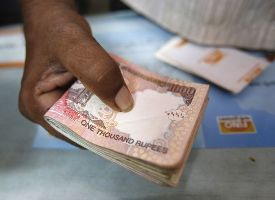 The government should stick to its promise of reducing the fiscal deficit to 3.5 per cent of gross domestic product, notes A K Bhattacharya, Editor, Business Standard
The government should stick to its promise of reducing the fiscal deficit to 3.5 per cent of gross domestic product, notes A K Bhattacharya, Editor, Business Standard
It is reassuring that the finance ministry has sought to end the speculation over the government's fiscal consolidation plan.
The statement, issued last week asserting that there is no plan to deviate from its earlier fiscal deficit reduction plan, draws strength from the government's track record in the current financial year.
In the first eight months of 2015-16, the fiscal deficit was 87 per cent of the full year's Budget estimate -- a distinct improvement over the 98.9 per cent reached in the same period in 2014-15.
And this has been achieved even while the effective revenue deficit declined by 20 per cent in the same period and the government's Plan expenditure rose to about 72 per cent of the Budget estimate for the full year, compared to only 51 per cent in the same period of 2014-15.
In other words, the fiscal deficit has been contained even while the government's Plan expenditure, which roughly corresponds to capital spending, has gone up.
It is true that this situation has been greatly helped by the falling international crude oil prices -- almost 70 per cent since June 2014.
But credit must also go to the government for having used this opportunity to speed up the roll-out of the direct benefits transfer scheme for cooking gas and to raise taxes on petroleum products to shore up its revenues.
This has certainly helped it continue with the planned capital expenditure, even though some of it has not been prudent, particularly for recapitalising public sector banks with stressed assets as the release of funds is not strictly linked to the banks' performance.
Even though the disinvestment proceeds in the current year may fall short of its target of Rs 69,500 crore (Rs 695 billion), the expectation is that the fiscal deficit target of 3.9 per cent of gross domestic product or gross domestic product for 2015-16 would be met, thanks largely due to the revenue buoyancy in indirect taxes and the poor absorptive capacity of many ministries in spending funds allocated for many projects as also for schemes in the social sector.
What should the government do for 2016-17?
Of course, it should stick to its promise of reducing the fiscal deficit to 3.5 per cent of gross domestic product.
Even after you assume nominal growth of about 12 per cent in 2016-17 (which is unlikely because, as seen in the current year, nominal growth may be only a little higher than real growth next year also) the fiscal deficit reduction of 0.4 percentage points translates into an expenditure compression of a small amount, assuming that the current year's nominal GDP size would be less than Rs 141 lakh crore (Rs 141 trillion).
This is not too difficult or imposing a task.
And there are many collateral advantages of taking the tough decision of meeting the promised fiscal deficit target for the coming year.
One, the finance minister cannot afford to lose credibility on the crucial question of meeting a target that he himself had set and particularly after having relaxed the earlier one just a year ago.
Two, reducing the fiscal deficit does result in making more resources available in the financial system for the private sector to tap into, and perhaps at a lower cost.
Three, at a time when the central bank has concerns over reducing interest rates for fear of stoking the inflation fire, it makes sense for the finance ministry to maintain fiscal rectitude since that in itself is likely to put a downward pressure on interest rates.
There are, of course, many economists who have argued that a little bit of relaxation in the promised fiscal deficit reduction plan should be tolerated because of the pressing need for increasing public investment at a time when the economy needs an investment boost and the private sector is too strained financially to be able to invest more in new or existing projects.
The illogic of the argument is that the Indian economy is no longer facing an either-or situation.
It needs to do both -- rein in the deficit and increase public investment.
Fortunately, the amount in question is relatively small. So, the challenge would be to find at least expenditure savings of that amount and minimise the additional demand for expenditure under other heads.
What can the government do?
One, as has been suggested in certain quarters, the recommendations of the Seventh Central Pay Commission could be postponed by a year with a clear directive that no arrears demand should arise from this decision.
The annual additional burden of the Pay Commission recommendations will be over Rs 1 lakh crore (Rs 1 trillion).
Postponing its enforcement by a year would be an unpopular decision, but would also show that the government is tough on expenditure management.
More importantly, political risks of such a decision are the least this year when Assembly elections are scheduled to be held in Assam, West Bengal, Tamil Nadu, Kerala and Puducherry.
The Bharatiya Janata Party does not have much of a chance in all these elections barring perhaps those in Assam.
So, risking its electoral chances this year with unpopular decisions and staying on the path of fiscal consolidation can be a prudent political strategy.
Indeed, the fact that this year will be politically less risky should guide the finance ministry to go for bolder steps on ushering in reforms by streamlining food and fertiliser subsidies, which account for over 80 per cent of the government's annual subsidies bill of Rs 2.4 lakh crore (Rs 2.4 trillion).
The use of the direct benefits transfer scheme for both the subsidies could help plug leakages and ensure that these are better targeted.
Similarly, a bold privatisation plan, after creating an institutional framework to implement it, could be another initiative next year to mop up additional resources.
The short point is that it is possible to stay on the path of fiscal consolidation and yet find additional resources for ramping up the much-needed public investment.
Loosening the fiscal policy in the name of providing more resources for investment would be a trap as this could turn the government away from reforms. And the finance ministry should not fall into it.












 © 2025
© 2025